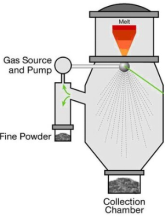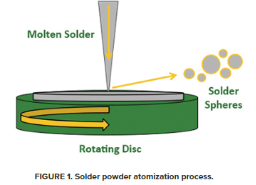Lead-Free Solder Paste Composition: How Are Alloy Solder Powders Made?
Lead-Free Solder Paste Composition: How Are Alloy Solder Powders Made?
Solder paste is one of the important materials for semiconductor package soldering, which play the role of fixing chips and forming electrical properties on the pads. Solder powder is one of the main components of solder paste, and it is a key factor in realizing chip fixation and electrical path. High-quality solder powders need a low degree of oxidation, uniform spheroids, and narrow particle size distribution. So how to manufacture solder alloy powder?
At present, the common methods used to manufacture solder powder in the industry include gas atomization and centrifugal atomization. Centrifugal atomization has attracted much attention due to its ability to produce solder powder with uniform particle size and excellent sphericity.
Gas Atomization
The gas atomization method needs to pass inert gas into the reactor. The alloy flows through the hole between the two nozzles after melted. Under the action of high pressure, the liquid solder is impacted by the gas ejected from the nozzle to form small metal droplets, which are deposited into the powder collection chamber after cooling. The solidified powder finally enters a series of screens for particle size screening. Solder powder stays in different sieves due to different particle size distributions.

Figure 1. Gas atomization mechanism.
Centrifugal Atomization
The centrifugal atomization method is widely used, and most manufacturers of solder powder currently adopt this method. Metal alloying, testing, and casting are conducted in the pre-atomization stage. Alloying is the preparation of metal solder powders according to the desired metal ratio. Alloys need to be tested after blending is complete. The more metal components, the more stringent the quality control is. Besides, attention should be paid to determining whether dopants are included. After the quality inspection is completed, the alloy can be cast into bars and await atomization.
After the metal enters the reactor, it is protected by inert gas and melted after being heated at a high temperature. The molten alloy is transferred to a small container. The container pours the collected liquid solder onto the centrifugal atomizing rotating disc. When the liquid solder hits the centrifugal atomizing rotating disk, it is deflected by centrifugal force into droplets, which form individual spheres by surface tension before cooling. The particle size uniformity and sphericity of the solder powder are mainly determined by this step. There are various methods of metal atomization for different manufacturers, leading to atomization technology patents.

Figure 2. Centrifugal atomization mechanism.
After the atomization is completed, the solder alloy powder is sieved according to the particle size by using vibrating screens. Many parameters affect the atomization effect, such as the melting point temperature of the alloy, the rotational speed of the centrifugal disc, and the internal environment of the reactor.
Fitech has complete centrifugal atomization equipment and a mature solder powder production process, which can produce alloy solder powder with narrow particle size distribution and high sphericity. Welcome to contact us for more information.


















 Back to list
Back to list



